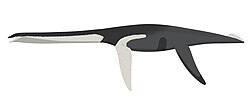| Cephalopods reported from the Quiriquina Formation |
|---|
| Genus | Species | Presence | Material | Notes | Images |
|---|
| Anagaudryceras [25] | A. politissimum | | Five specimens | A gaudryceratid ammonite | |
| A. subtilineatum | | Three juvenile specimens | A gaudryceratid ammonite | |
| Baculites [25] | B. anceps | - Colchogüe
- Las Tablas
- Lirquén
- San Vicente
- Santa Sabina
- Tomé
| 40 specimens | A baculitid ammonite | |
| B. huenickeni | - Colchogüe
- Las Tablas
- San Vicente
- Santa Sabina
| 32 specimens | A baculitid ammonite | |
| Diplomoceras [24] [25] | D. cylindraceum | - Colchogüe
- Las Tablas
- Loanco
- San Vicente
| Seven specimens | A diplomoceratid ammonite | |
| Gaudryceras [25] | G. kayei | - Colchogüe
- San Vicente
- Las Tablas
- Lirquén
- Tomé
| Six specimens | A gaudryceratid ammonite | |
| Eubaculites [24] [25] | E. carinatus | - Colchogüe
- Las Tablas
- Laguna Lo Méndez
- Lirquén
- Loanco
| 56 specimens | A baculitid ammonite | |
| Grossouvrites [24] [25] | G. gemmatus | - Las Tablas
- Loanco
- San Vicente
| Nine specimens | A kossmaticeratid ammonite | |
| G. joharae | - Colchogüe
- Las Tablas
- Loanco
| Six specimens | A kossmaticeratid ammonite | |
| Gunnarites [25] | G. cf. bhavaniformis | San Vicente | Two fragments | A kossmaticeratid ammonite | |
| Hoploscaphites [25] | H. constrictus quiriquiniensis | | 51 specimens | A scaphitid ammonite | |
| Hypophylloceras [25] | H. (Neophylloceras) hetonaiense | - Las Tablas
- Colchogüe
- Tomé
- Lirquén
| 20 specimens | A phylloceratid ammonite | |
| H. (Neophylloceras) inflatum | | Seven specimens | A phylloceratid ammonite | |
| H. (Neophylloceras) ramosum | - Las Tablas
- Los Viejos
- Colchogüe
- Tomé
| 17 specimens | A phylloceratid ammonite | |
| H. (Neophylloceras) surya | | Three specimens | A phylloceratid ammonite | |
| Kitchinites [25] | K. darwini | - Colchogüe
- Las Tablas
- Santa Sabina
| 30 specimens | A desmoceratid ammonite | |
| K. ifrimae | Colchogüe | Four specimens | A desmoceratid ammonite | |
| K. vicentensis | San Vicente | Four specimens | A desmoceratid ammonite | |
| Kossmaticeras [25] | K. (Natalites) erbeni | - Colchogüe
- Las Tablas
- San Vicente
- Tomé
| Nine specimens | A kossmaticeratid ammonite | |
| Maorites [25] | M. densicostatus | | Six specimens | A kossmaticeratid ammonite | |
| Menuites [25] [26] | M. gerardoi | San Vicente | Seven specimens | A pachydiscid ammonite | |
| M. fresvillensis | | Eight specimens | A pachydiscid ammonite | |
| Naefia [27] | N. neogaeia | Quiriquina Island | Shell | A groenlandibelid | |
| Pachydiscus [25] | P. (Pachydiscus) gutierrezi | - Colchogüe
- Las Tablas
- Lirquén
- Puente Perales
| 14 specimens | A pachydiscid ammonite | |
| P. (Pachydiscus) jacquoti chilensis | | Three specimens | A pachydiscid ammonite | |
| Phyllopachyceras [25] | P. forbesianum | Las Tablas | One specimen | A phylloceratid ammonite | |
| Phylloptychoceras [25] | P. sp. | Tomé | Five fragments | A diplomoceratid ammonite | |
| Pseudophyllites [24] [25] | P. indra | - Colchogüe
- Las Tablas
- Loanco
| Five specimen | A tetragonitid ammonite | |
| Trachybaculites [25] | T. vicentei | San Vicente | One specimen | A baculitid ammonite | |
| Zelandites [25] | Z. varuna | - Colchogüe
- Las Tablas
- Los Viejos
- Lirquén
- Tomé
| 11 specimens | A gaudryceratid ammonite | |
|







